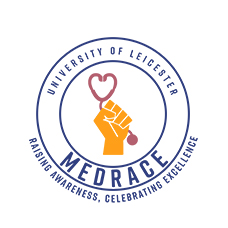College of Life Sciences
Evaluating MedRACE in my year 5 SSC project
Ese Oyokose, Student, Leicester Medical School
Is MedRACE an effective way of promoting educational equity? What aspects of it work?

I decided to work with MedRACE for my Student Selectected Componenent (SSC) project as I had briefly heard about the group (via friends or in emails) but I didn’t know much about what they did and wanted to learn more. For this project, I initially wanted to focus on the relationship between Black and Asian patients and mental health services, as I have a special interest in Psychiatry. However, in my initial meeting with my supervisors they said they were keen to find a student who had not been heavily involved with the MedRACE group to conduct an independent evaluation of the group. This evaluation would consist of lots of background reading, lots of interviews and lots of writing. It did seem like a lot of work, but I knew it would be an amazing opportunity to properly understand what MedRACE does and to see if it has affected change in any way and if so, how.
Reflections
Whilst reviewing MedRACE’s work, I was amazed by the range of projects that they had developed and the changes that they have achieved in the medical school. Discovering that students have been able to make some of our teaching materials more diverse and inclusive, via their MedRACE projects, made me proud. I only realised the importance of having diversity in the teaching material after being exposed to patients having the same skin condition but it sometimes presenting differently on patients with darker skin tones, whilst on placement. The patient population in the UK is so diverse and being able to see that Leicester medical students are now more exposed to diverse teaching materials makes me happy.
As part of the evaluation, I interviewed a range of people including students, staff (including the head and deputy heads of school) and external stakeholders from the BMA and Medical Schools Council EDI alliance. The qualitative interviews that I conducted, during the evaluation, allowed me to produce a body of work that helped me to understand what enabled MedRACE to achieve its outcomes and also what could be improved. The interviews highlighted a range of key factors that have allowed MedRACE to be effective in promoting educational equity and different factors were identified to assist in MedRACE’s development. Hopefully, this project will also play a part in helping MedRACE find ways to continue to recruit more students and staff that are passionate about Equality, Diversity and Inclusion (EDI) work in the medical school.
Working with the staff and students, that are a part of MedRACE, has been an amazing experience and I have learnt so much about the importance of embedding Equity, Diversity and Inclusion in our medical education, for both the students and the patients we treat.
July 2023
